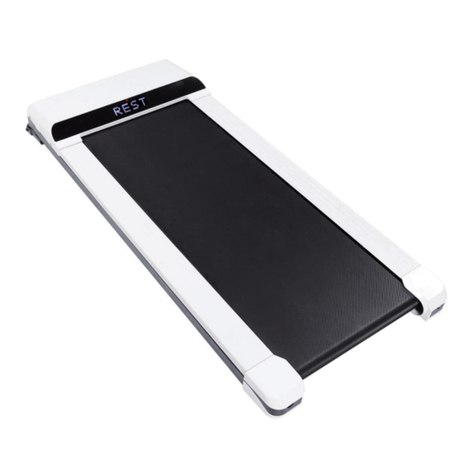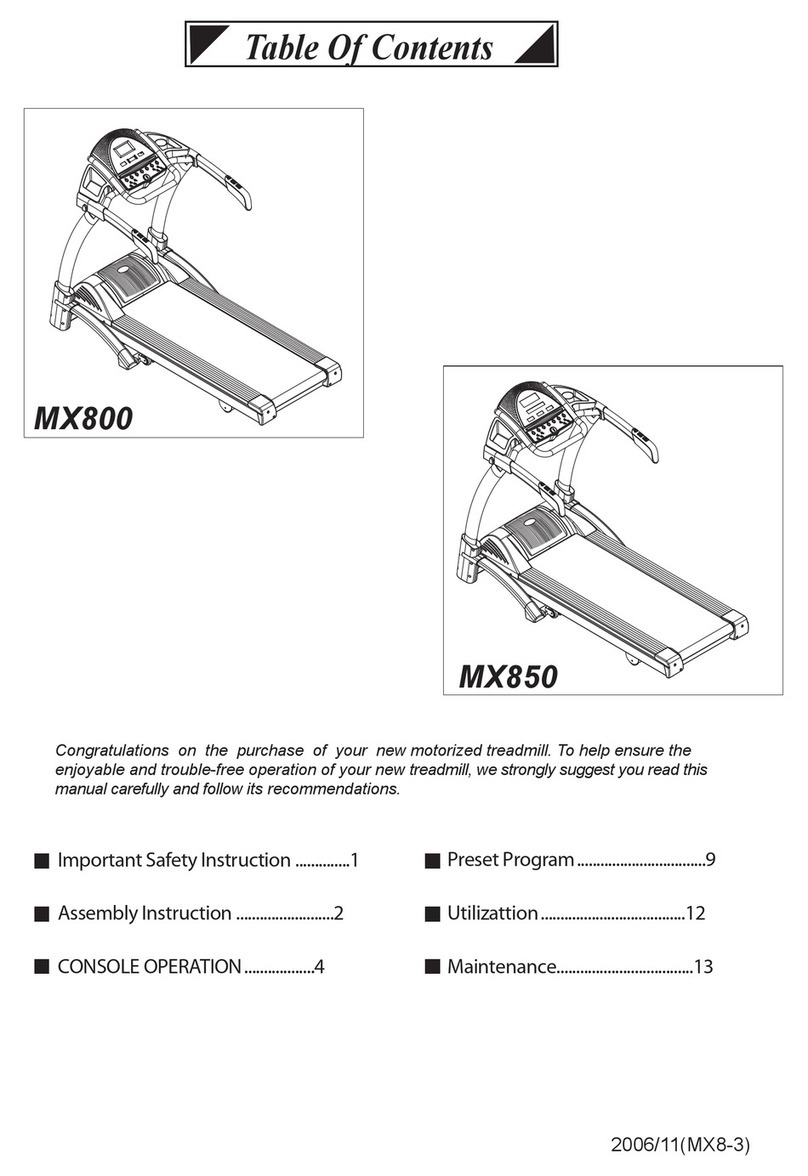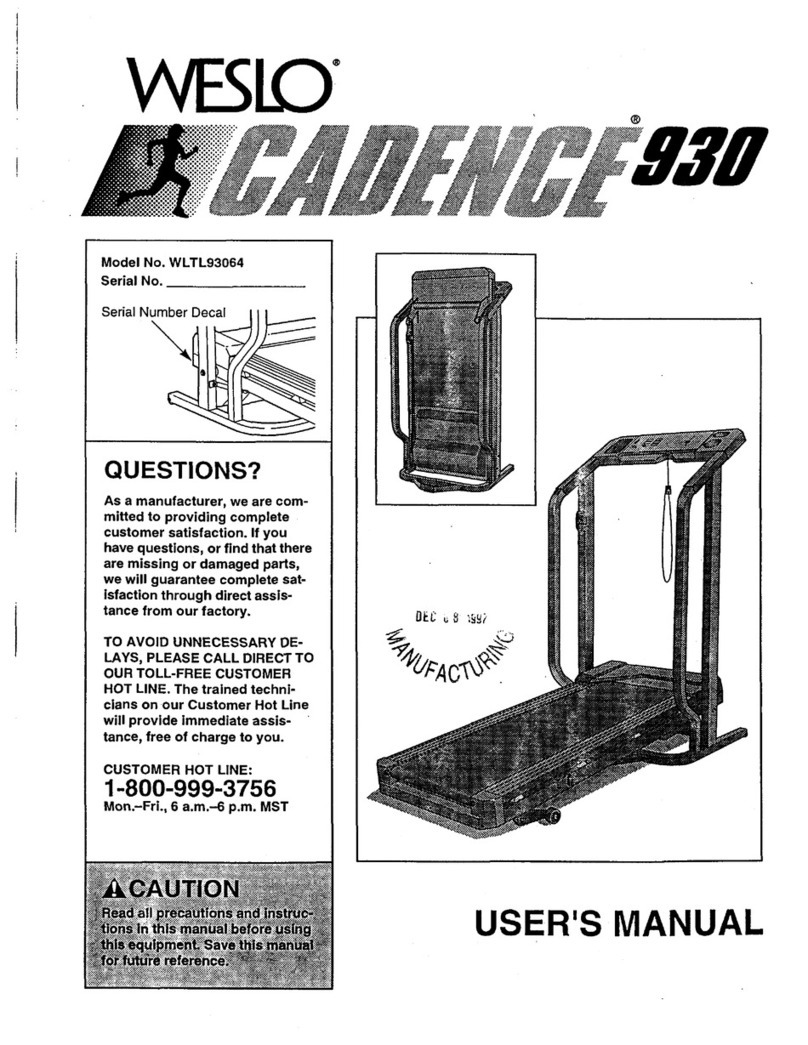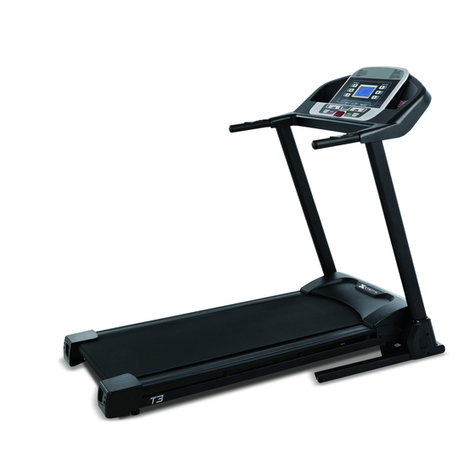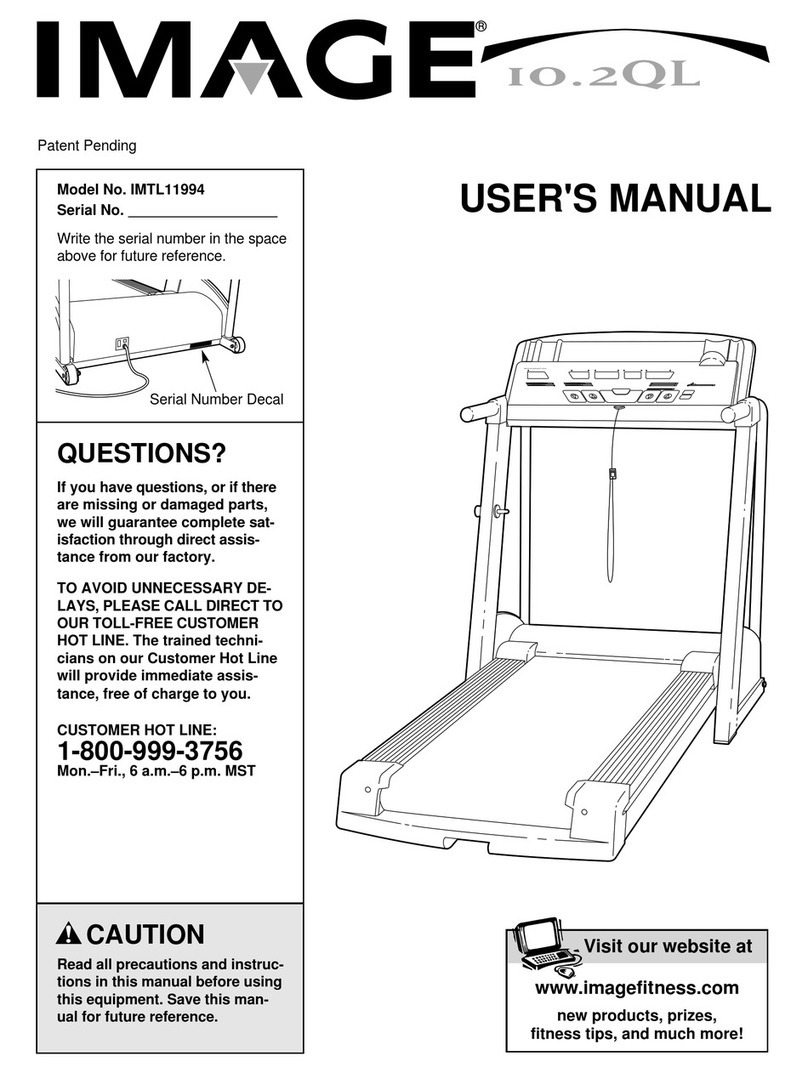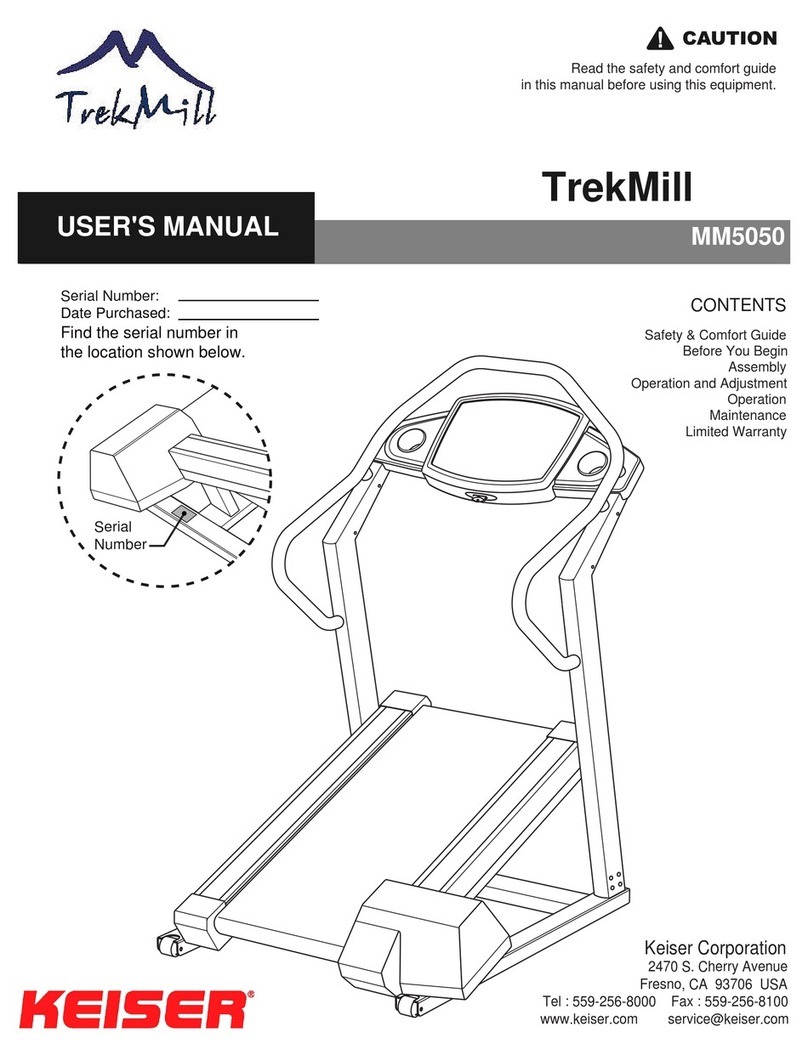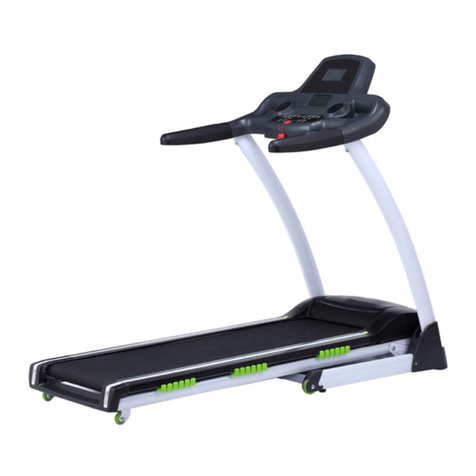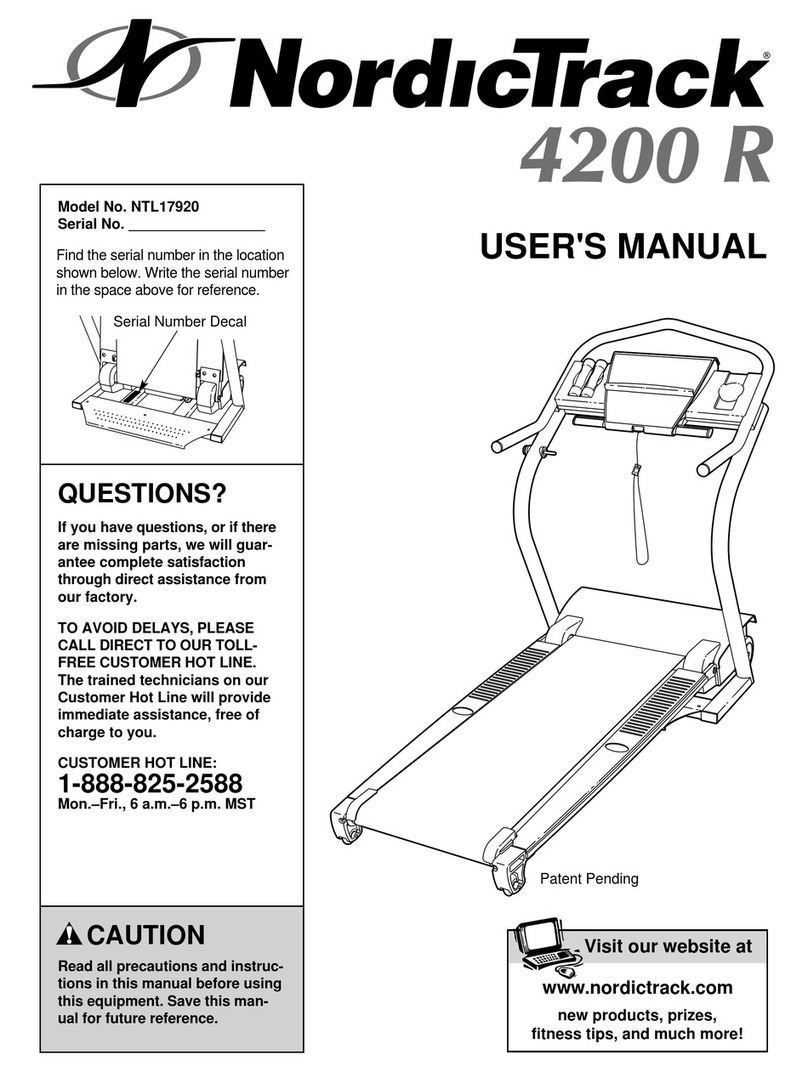Proaction BT7020 Operator's manual

BT7020
Instrucciones de montaje y utilización
Instructions for assembly and use

2
Fig.0
Fig.1

3
Fig.2
Fig.3

4
Fig.4
Fig.5

5
Fig.6
Fig.7 Fig.8

6
Español
INDICACIONES GENERALES.-
Lea atentamente las instrucciones de
este manual. Este le da indicaciones
importantes sobre la seguridad, el uso y
el mantenimiento de la cinta de andar.
Siga las siguientes recomendaciones:
1 Esta unidad esta diseñada para uso
doméstico únicamente.
2 La cinta de andar sólo puede ser
usada por una persona al mismo
tiempo. Deberá ser usada solamente
por personas cuyo peso sea 115Kg. o
menos.
3 Coloque su unidad en una superficie
plana, con al menos 2 metros de
espacio en la parte posterior y 1 metro
alrededor. No coloque su unidad cerca
de una superficie que pueda bloquear
cualquier apertura de aire. Para
proteger el piso o la alfombra de algún
daño, coloque un tapete debajo de su
unidad.
4 Su unidad dispone de una llave de
seguridad. Ésta deberá estar
introducida en su alojamiento. En
caso contrario, la máquina no se
pondrá en marcha. Cuando haga uso
de la máquina, fije la cuerda a la ropa
mediante el clip.
Quite la llave de seguridad si esta no
va a ser usada y guárdela fuera del
alcance de los niños y de terceras
personas.
5 Antes de utilizar la cinta de andar,
asegúrese de que funciona
correctamente. No utilice un aparato
que pueda estar dañado.
6 Es responsabilidad del propietario
asegurarse que todos los usuarios de
la máquina de andar estén adecuados
informados sobre todas las
precauciones necesarias.
7 Los padres y otras personas
responsables de los niños deber de
tener en cuenta la naturaleza curiosa
de éstos y que puede llevarles a
situaciones y conductas que pueden
resultar peligrosas. Este aparato no
ha de utilizarse en ningún caso como
juguete.
8 No permita que los niños o
personas discapacitadas utilicen el
aparato sin la estricta supervisión de
una persona cualificada.
9 En caso de emergencia, coloque los
pies en los rieles agarrándose en la
barandilla hasta que la unidad se
detenga.
10 Utilice la barandilla para subir y
bajar de la cinta de andar y para
cambiar de velocidad. No salte de la
cinta cuando esté en movimiento.
11 Mantenga las manos alejadas de
cualquiera de las partes móviles. No
coloque las manos, pies o cualquier
otro objeto bajo la cinta de andar.
12 No se pare sobre la cinta cuando
esté funcionando.
13 Utilice prendas de vestir y calzado
adecuados. Átese los cordones
correctamente. Para evitar lesiones y
un desgaste innecesario de la banda,
asegúrese de que el calzado no tenga
suciedad.
14 Nunca utilice la máquina al aire
libre.
15 No es aconsejable mantener su
unidad permanente en un lugar
húmedo debido a que la oxidación
sería inevitable.

7
16 Tenga cuidado de no lubricar en
exceso ya que se puede manchar el
suelo o las alfombras donde la unidad
esté colocada.
17 No use accesorios no
recomendados por el fabricante.
INSTRUCCIONES DE
SEGURIDAD.-
Este producto debe conectarse a tierra.
Si no funciona correctamente o se ha
averiado, la conexión a tierra
proporciona un recorrido de menor
resistencia para la corriente eléctrica y
reducir el riesgo de descargas
eléctricas. Este producto está equipado
con un cable que tiene un conductor de
tierra y un enchufe con toma de tierra.
El enchufe debe conectarse en una
toma apropiada, correctamente
instalada y conectada a tierra, de
acuerdo con la normativa local.
¡PELIGRO!: Una conexión incorrecta
del conductor del equipo a tierra
puede dar como resultado el riesgo de
descargas eléctricas. En caso de
dudas, consulte a un electricista o
técnico especializado. No modifique el
enchufe que incluye el aparato; si no
encaja en la toma eléctrica, solicite a
un electricista la instalación de una
toma adecuada.
Este producto debe utilizarse en un
circuito de 220-240 voltios y tiene una
clavija de tierra similar a la que se
muestra en la figura A. Asegúrese de
que el aparato se conecta a una toma
con la misma configuración que el
enchufe. No utilice ningún adaptador
con este aparato.
Siempre que utilice un aparato
eléctrico, deberá seguir estas
recomendaciones:
1 Antes de enchufar la unidad
compruebe si el voltaje de su instalación
coincide con el de la máquina. El voltaje
de su instalación debe ser el que marca
en la etiqueta de características y debe
asegurarse de que está conectada a
una salida con la misma configuración
del enchufe.
2 Para reducir el riesgo de sacudidas
eléctricas, ponga el interruptor en la
posición «0» y entonces desenchufe
de la red. Desenchufe siempre la
unidad inmediatamente después de
su utilización.
3 Asegúrese de que la cinta de andar
está desenchufada y desconectada
antes de comenzar cualquier
procedimiento de montaje,
mantenimiento y antes de proceder a
su limpieza.
4 No desenchufe la cinta de andar
tirando del cable.
5 No utilice la máquina con el cable
eléctrico dañado o desgastado.
6 Mantenga el cable eléctrico lejos de
superficies calientes.
PROTECCIÓN.-
Este modelo esta dotado de una
protección electrónica de parada
automática para una óptima
conservación de los circuitos tanto
electrónicos como eléctricos.

8
Esta protección se activará si la unidad
es sometida a un esfuerzo o
calentamiento anormal. Si esto
ocurriese:
1.- Ponga el interruptor (L) situado en
la carcasa en la posición «0» (OFF).
2.- Presione el interruptor de circuito
(C) para resetear.
3.- A continuación ponga el citado
interruptor en la posición «I» (ON) y la
unidad se encontrará preparada de
nuevo para su uso.
En caso de que la protección se
activará repetidamente, las causas
probables son:
- condiciones de trabajo anormales,
- falta de lubricación de la banda,
- utilización de lubricantes con disolventes.
- banda demasiado tensa.
Conecte la unidad a un enchufe
provisto de terminal TIERRA. Ponga el
interruptor (L) en posición [1] Fig.B.
Fig.B
INSTRUCCIONES DE
MONTAJE.-
Se recomienda la ayuda de una
segunda persona para el montaje.
Compruebe que tiene todas las
piezas, Fig.0:
(1) Estructura principal; (20) Llave allen;
(55) Bote de lubricante; (96) Cable
alimentación; (103) Cable MP3; (128)
Llave de seguridad.
Siga cada uno de los pasos de las
instrucciones de este montaje.
1 Saque la unidad de la caja y
colóquela en el suelo como muestra la
Fig.1.
2 A continuación pise la palanca
(135), Fig.1. Se oirá un click. Levante
las columnas hacía arriba hasta que
oiga otro click.
3 Sujete el monitor con una mano y
con la otra desenrosque el pomo
(147) girándolo 3-5 vueltas en sentido
antihorario, Fig.2, y luego tire de él
hacia fuera. Levante el monitor hasta
colocarlo en su posición y gire el
pomo (147) en sentido horario para
fijar la posición, Fig.2.
4 Pulse la palanca del pasamanos con
el dedo y gíre el pasamanos según
indica la Fig.3 para ponerlo en
posición. Haga lo mismo con el otro
pasamanos, Fig.3.
5 Coloque la llave de seguridad (128)
en su compartimento, Fig.4.
PLEGADO DE SU UNIDAD.-
Esta cinta de correr dispone de un
mecanismo de plegado para
guardarla. Para ello, pare el
movimiento de la cinta y desenchufe
el cable de la red eléctrica.
Pulse la palanca del pasamanos y gire
ambos pasamanos según indica Fig.5,
I.
Sujete el monitor con una mano y con
la otra gire el pomo (147) en sentido
antihorario 3-5 veces y luego tire de él
hacia fuera. Baje el monitor hasta que
se quede en paralelo con las
columnas, Fig.5; II.
A continuacion, coja del mástil
izquierdo o derecho y pise la palanca
(135), Fig.5, III. Se oirá un click. Baje
los mástiles hacia el suelo.

9
Extraiga los soportes delanteros antes
de transportar o levantar la cinta,
Fig.5, IV.
MOVIMIENTO Y ALMACENAJE.-
La unidad está equipada con ruedas
(33), Fig.6, lo que hace más sencillo su
movimiento. Asegúrese de que el cable
eléctrico está desenchufado de la red
eléctrica.
Si desea mover la cinta en primer lugar
deberá plegarla, coloque las manos
según indica la Fig.6 y levántela hasta
apoyar las ruedas de transporte (33)
en el suelo.
Para evitar peligros, NO mueva la cinta
sobre suelos que no sean lisos.
MANTENIMIENTO.-
Para un óptimo mantenimiento de su
unidad, y que la fricción entre la banda
y la tabla sea la mínima, lubrique la
parte interior, Fig.7 (debido a los
diferentes estilos de correr lubrique con
mas atención la zona donde usted
apoya los pies al realizar el ejercicio)
con el bote de lubricante.
Se recomienda lubricar la base de la
cinta entre la tabla y la banda según la
frecuencia de uso.
Nº de horas
sema
nales
<=7
>7
Velocidad
(Km/h)
<6 1 mes 1 mes
>6 2
meses
1 mes
Nota: Este programa de mantenimiento
preventivo está destinado,
exclusivamente, para uso doméstico.
Para usos comerciales se recomienda el
mantenimiento mensual de la unidad.
En ambientes
agresivos, con gran
dispersión de partículas o con personas
de peso elevado la frecuencia de
lubricación debe aumentarse
consecuentemente.
Tras lubricar, si la banda resbala,
compruebe la tensión de la misma. Para
tensar la banda coja la llave de allen de
6mm. y con la máquina a 4Km/h gire los
tornillos (R y L) una vuelta en sentido de
las agujas del reloj.
ATENCIÓN: El uso de lubricante
diferente al suministrado por el
fabricante o la falta de lubricación,
conlleva la pérdida de la garantía.
AJUSTE DE BANDA.-
Un mal asentamiento de la unidad en
los cuatro puntos de apoyo puede
producir un desplazamiento lateral de
la banda (X). Un riguroso control de
calidad regula y comprueba la banda
de deslizamiento. Sin embargo, debido
a las diferencias de peso y a los
individuales estilos de correr, puede
sufrir desplazamientos laterales.
Si la banda se desvía a la derecha o la
izquierda, pare la unidad.
DESPLAZAMIENTO DE LA BANDA
HACIA LA DERECHA.-
Esta acción es muy importante. Siga
estos pasos. Para proceder al ajuste
de la banda ponga la unidad a una
velocidad de 4Km/h. En el caso de que
la banda se haya desplazado hacia la
derecha, gire el tornillo (R) del lado
derecho de su máquina 1/4 de vuelta
en el sentido de las agujas del reloj.
Observe la posición de la banda, si al
cabo de un minuto la banda no queda
totalmente centrada, repita la operación.
Si observa un desplazamiento excesivo
de la banda hacia la izquierda, proceda a
girar ligeramente el tornillo derecho en el

10
sentido contrario al de las agujas del reloj
Fig.8.
Una vez ajustada la cinta de correr,
puede comenzar el ejercicio de nuevo.
DESPLAZAMIENTO DE LA BANDA
HACIA LA IZQUIERDA.-
Caso de que la banda se haya
desplazado hacia la izquierda, gire el
tornillo (L) del lado izquierdo de su
máquina 1/4 de vuelta en el sentido de
las agujas del reloj. Observe la
posición de la banda, si al cabo de un
minuto la banda no queda totalmente
centrada, repita la operación.
Si observa un desplazamiento excesi-
vo de la banda hacia la derecha,
proceda a girar ligeramente el tornillo
izquierdo en el sentido contrario al de
las agujas del reloj. Fig.8.
Importante: Una excesiva tensión de
la banda puede llevar a la pérdida de
velocidad de su máquina e incluso a
deformaciones de la banda. Por ello,
tenga en cuenta que produce el mismo
efecto sobre la posición de la banda un
giro en el sentido de las agujas del reloj
del tornillo derecho (R) que un giro en
el sentido contrario al de las agujas del
reloj en el tornillo izquierdo (L). Con lo
cual en el caso de desplazamientos
excesivos, puede proceder alternativa-
mente con uno u otro tornillo para
evitar tensiones excesivas de la banda.
INSTRUCCIONES DE USO.-
CONDICION FISICA.
Estar en forma física, significa vivir
plenamente. El tipo de vida en las
grandes ciudades es básicamente
sedentario. Nuestro régimen se ha
vuelto demasiado rico en calorías y
grasas. Los médicos son unánimes en
recomendar la práctica regular de
ejercicio para controlar nuestro peso,
mejorar nuestra forma física y
relajarnos.
VENTAJAS DE LA PRÁCTICA
DE EJERCICIO.-
Un ejercicio regular por debajo de cierto
nivel y de una duración de 15/20
minutos, se vuelve aeróbico. El ejercicio
aeróbico es el ejercicio que utiliza
oxígeno fundamentalmente.
Normalmente se tratará de un ejercicio
continuo sin pausas. En efecto, además
de azúcar y grasa, el cuerpo tiene
necesidad de oxígeno.
La práctica regular de un ejercicio,
mejora la facultad del cuerpo para
suministrar oxígeno a todos sus
músculos, al mismo tiempo mejora la
función pulmonar, la capacidad de
bombeo del corazón y se facilita la
circulación sanguínea. En resumen, la
energía desarrollada con la práctica de
un ejercicio quema kilocalorías
(conocidas como calorías).
EJERCICIO Y CONTROL DE
PESO.-
Nuestra alimentación se traduce entre
otros elementos, en energía (calorías)
para nuestro organismo. Si
consumimos más calorías que las que
quemamos, el resultado es un aumento
de peso y viceversa, si se queman más
calorías que las consumidas se pierde
peso. En reposo nuestro cuerpo quema
alrededor de 70 calorías por hora para
mantener activas las funciones vitales.
El trabajo realizado por el organismo
viene reflejado en el ritmo cardiaco
(pulsaciones), que aumenta cuando la
intensidad de trabajo aumenta. En el
caso de la máquina de andar, el
esfuerzo depende de la velocidad y de

11
la inclinación. El aumento de la
velocidad conlleva un aumento de la
intensidad de trabajo y, por lo tanto,
un aumento del ritmo cardiaco. En el
supuesto de que la intensidad del
trabajo se mantenga constante, es
decir, tensión y ritmo de pedaleo
constantes, el ritmo cardiaco aumenta
hasta un punto en el cual permanece
invariable.
Al máximo número de pulsaciones
que una persona nunca debe
sobrepasar se le denomina ritmo
máximo y éste disminuye con la edad.
Una sencilla fórmula para calcular es
restar a 220 la edad en años. El
ejercicio, para que sea correcto, debe
mantenerse de 15 a 20 minutos entre
el 65 y el 85% del riemo cardiaco
máximo y se recomienda no
sobrepasar el 85%.
En el monitor de su máquina de andar
la zona aeróbica queda representada
por dos zonas. La primera
corresponde a un esfuerzo ligero
entre el 65 y el 74% del ritmo cardiaco
máximo y la segunda a esfuerzos
elevados entre el 75 y el 85% para
personas entrenadas.
EJEMPLO: Edad 50 años
220-50= 170 pulsaciones
Ritmo
cardiaco
Pulsaciones
Máximo 170
85% 144 Zona
aeróbica
75% 127
65% 112
PROGRAMA DE EJERCICIO.-
Antes de comenzar cualquier
programa de ejercicio y teniendo en
cuenta que programas de ejercicio
varían en función de la edad y del
estado físico, es recomendable una
consulta a su médico, ya que con sus
sugerencias o recomendaciones
especificas logrará mejores
resultados.
Sea su objetivo final una mejora de su
forma física, un control de su peso o
una rehabilitación, tenga en cuenta
que su ejercicio debe ser progresivo,
planificado, variado y sin exceso.
Recomendamos que la frecuencia de
sus ejercicios sea de 3 a 5 veces por
semana.
Antes de comenzar una sesión es
importante realizar un calentamiento
de unos 2-3 minutos con una
velocidad suave. Ello protegerá sus
músculos y preparará adecuadamente
su sistema cardiorrespiratorio.
El siguiente paso será durante 15-20
minutos con un ritmo que le lleve a un
número de pulsaciones situado entre
el 65 y el 75% o entre el 75 y el 85%
en el caso de personas entrenadas.
Más adelante, cuando hayamos
mejorado nuestra forma física,
podemos repartir el tiempo entre

12
ambos niveles, pero teniendo en
cuenta que el número de pulsaciones
no debe sobrepasar el 85% (zona
aeróbica) y nunca llegar al máximo
ritmo cardíaco que no podemos
sobrepasar de acuerdo a nuestra edad.
Finalmente, es importante relajar sus
músculos. Para ello basta andar con
una velocidad ligera durante 2-3
minutos hasta que sus pulsaciones
bajen de la línea del 65%. Esto evitará
dolores musculares, sobre todo
después de una sesión intensa. Es
también recomendable acabar el
programa con unos ejercicios de
relajación en el suelo.
NOTA FINAL.
Esperamos que disfrute de su unidad.
Con su programa controlado de
ejercicios se dará cuenta de las
ventajas, de sentirse mejor, con más
vigor y con más resistencia a la
tensión. Juzgará por sí mismo que
merece la pena mantenerse en forma.
INSPECCIONES Y
MANTENIMIENTO.-
Desconecte la unidad y desenchufe el
cable de la red.
Limpie el polvo de las superficies de la
cinta de andar especialmente las
barandillas y la consola electrónica
con un paño o una toalla húmeda. No
utilice disolventes.
Utilice un aspirador para aspirar
cuidadosamente alrededor de todos
los componentes visibles (cinta,
estructura, etc.). Apoyando la unidad
sobre uno de los laterales también se
puede aspirar la parte inferior. Aspire
también el interior de la caja del motor
soltando la tapa que protege el motor
(tenga cuidado con los cables).
ATENCIÓN:
Compruebe periódicamente que todos
los elementos de sujeción estén
debidamente apretados y
correctamente conectados.
Revise y apriete todas las partes de
su unidad cada tres meses.
El uso de esta máquina con partes
gastada o debilitada como por ejemplo
la correa, la banda de deslizamiento o
los rodillos podría lesionar al usuario.
Cuando tenga duda sobre la condición
de cualquier parte de la maquina, no
dude en ponerse en contacto con el
(S.A.T).Servicio de Asistencia
Técnica, llamando al teléfono de
atención al cliente (ver página final del
presente manual).
EL FABRICANTE SE RESERVA EL
DERECHO A MODIFICAR LAS
ESPECIFICACIONES DE SUS
PRODUCTOS SIN PREVIO AVISO.

13
LOCALIZACIÓN DE FALLOS O AVERÍAS
SÍNTOMAS COMPROBACIONES SOLUCIONES
1. No se enciende el
monitor.
1) Asegúrese de que la
máquina está enchufa
da a la
red, el interruptor general en
posición 1 y la llave de
seguridad puesta.
1) Enchufe el cable a la
red. Coloque el interruptor
en posición 1 y ponga la
llave de seguridad.
2. Se enciende el
monitor y no
funciona el motor.
2) Comprobar que el limit
ador
de corriente esté hacia
dentro.
2) Desconectar la máquina
y pulsar el limitador de
corriente. Lubricar la
banda.
3. Tirones al andar
encima de la banda.
3.a) Comprobar lubricación
banda
3.b) Comprobar tensión
banda deslizamiento
3.c) Comprobar tensió
n
correa de transmisión
3.a) Lubricar la banda de
deslizamiento .
3.b) Tensar la banda de
deslizamiento.
3.c) Tensar la correa de
transmisión.
4. La máquina se
para (salta el
limitador de
corriente).
4) Comprobar lubricación
banda
4) Pulsar el limitador
de
corriente con el interruptor
en 0 y lubricar la banda de
deslizamiento.
5. La barandilla da
calambres en las
manos.
5) Comprobar que el enchufe
donde está conectada tiene
toma tierra
5) Enchufar la máquina en
enchufe con toma de tierra.
6. La banda se
descentra.
6.a) Comprobar nivelación
del suelo.
6.b) Comprobar la cojera de
la máquina.

14
English
GENERAL INSTRUCTIONS.-
Carefully read through the instructions
contained in this manual. It provides
you with important information about
safety, use and maintenance of the
treadmill.
You should always observe certain
safety precautions when using this
unit, including the following:
1 This unit has been designed for
home use only.
2 Your unit can only be used by one
person at a time. It can only be used
by people who weigh 115 kg or less.
3 Place your unit on a flat surface,
with at least 2 metres of free space at
the rear and 1 m around. Do not place
your unit on any surface that might
block a ventilation opening. Place a
protective sheet below your unit to
protect the floor or carpet from
possible damage.
4 Your unit is equipped with a safety
key. The safety key must be inserted
into its housing, otherwise the
machine will not operate. When you
are using the machine always clip the
cord on the safety key to your clothing.
Remove the safety key whenever the
machine is not being used and keep it
safe from children and others.
5 Make sure that the treadmill unit
operates correctly before attempting to
use it. Never use an appliance that
might be faulty.
6 The owner is responsible for
ensuring that anyone who uses the
machine is duly informed about all of
the necessary precautions.
7 Parents and/or those responsible for
children must always be aware of their
curious nature and how this can often
lead to hazardous situations and
behaviour which could cause
accidents. This is why they should
always be supervised. Under no
circumstances should this appliance
be used as a toy.
8 Do not allow children or the disabled
to use the appliance without the strict
supervision of a qualified person.
9 In the event of any emergency, place
your feet on the side rails and hold onto
the handrail until the unit stops.
10 Use the handrail to help you get on
and off the treadmill and when
changing the speed. Do not jump onto
the belt while it is moving.
11 Keep your hands well away from
any of the moving parts. Do not place
your hands, feet or any other object
below the treadmill belt.
12 Do not stand still on the belt while
it is moving.
13 Use suitable clothing and footwear.
Make sure that all laces/cords are tied
correctly. To avoid injury and
unnecessary wear on the belt, make
sure that your footwear is not dirty.
14 Do not use the machine outdoors.
15 It is not advisable to keep your unit
in a damp place for long periods as it
will be prone to rust.
16 Make sure not to overlubricate the
unit as this might stain the floor or
carpeting where the unit stands.
17 Never use accessories not
recommended by the manufacturer.

15
SAFETY INSTRUCTIONS.-
This product must have an earth
connection. In the event that the
appliance malfunctions then the earth
connection will redirect the electrical
current away from the machine and
reduce the risk of an electrical shock.
This product is supplied with a mains
cable that has an earth wire and a
plug with an earth pin. The plug must
only be used with an appropriate wall
socket, installed correctly and
connected to earth, in accordance with
local regulations.
DANGER! If the equipment is not
earthed correctly then there is a risk of
electrical shock. If in doubt, get an
electrician or technical specialist to
check that the earth connection is
correct. Do not modify the plug
supplied with the equipment, if it does
not fit the wall socket then get an
electrician to install an electrical
socket that does.
This product must only be used on a
220-240 volt circuit, with an earthed
socket similar to that shown in Fig.A.
Make sure that the appliance is only
connected to a wall socket with the
same pin layout as the plug. Do not
use an adaptor with this appliance.
Always observe the following
recommendations when using
electrical appliances:
1 Make sure that the mains supply
voltage matches that of the machine
before plugging it in. The supply
voltage must be the same as that
stated on the characteristics plate and
the holes in wall socket must match
the pins for plug on the machine.
2 To reduce the risk of electrical
shock, first put the switch to the “0”
position and then unplug it from the
wall socket. Always unplug the unit
immediately after use and before
proceeding to clean it.
3 Make sure that the treadmill is
switched off and unplugged before
beginning any type of maintenance or
assembly work on it.
4 Do not unplug the treadmill by
tugging on the mains cable.
5 Do not use the machine if the mains
cable becomes damaged or worn.
6 Keep the mains cable away from hot
surfaces.
SAFETY BREAKER.-
This model is equipped with an
electronic circuit breaker to protect both
the electronic and electrical circuits.
This safety device will be automatically
triggered if the unit is subjected to
abnormal force or heat.
Should this occur:
1.- Set switch (L), located on the
casing, to the “0” (OFF) position Fig.B.
2.- Press the circuit button (C) to reset
the unit.
3.- Next, set switch (L) to the “I” (ON)
position and the unit will be ready for
use again.
Should the circuit breaker trip
repeatedly then the most probable
causes are:
-Abnormal working conditions,
-Treadmill belt in need of lubricant,

16
-Solvent based lubricants used,
- Belt is too tight.
Plug the unit into a wall socket with an
EARTH terminal. Set switch (L) to
Position [1].
Fig.B
ASSEMBLY INSTRUCTIONS.-
The assistance of a second person
is advisable for the assembly work.
Make sure that all of the pieces are
there, Fig.0:
(1) Main structure; (20) L-type wrench;
(55) Silicone oil; (96) Power cord; (103)
MP3 wire; (128) Safety key.
Follow the instructions step by step to
assemble:
1 Take the unit out of the box and
place it on the floor as shown in Fig.1.
2 Press the lever (135) with your foot,
Fig.1. You will hear a click sound. Lift
the columns until you hear another
click sound.
3 Hold the monitor with one hand and
unscrew the knob (147) with the other
by turning it 3-5 rounds
counterclockwise, Fig.2, and then pull
the knob out. Raise the monitor into
position and turn the knob (147)
clockwise to fix the position, Fig.2.
4 Press the handrail lever with your
finger and turn the handrail as shown
in Fig.3 to put it in position. Do the
same with the other handrail, Fig.3.
5 Put the security key (128) in its
compartment, Fig.4.
FOLDING YOUR UNIT.-
This treadmill is equipped with a
folding mechanism for storage
purposes. To use it, stop the treadmill
and unplug the mains cable.
and lift the unit until you hear lever
click into place, Fig.7. Store your unit
in a dry place, preferably not subject
to changes in temperature.
UNFOLDING YOUR UNIT.-
If you wish to use the treadmill, do the
reverse procedure. Use your foot to
press lever as shown in Fig.8 and
slowly lower the treadmill belt down to
the floor.
Press the handrail lever with your
finger and turn the handrails as shown
in Fig.5, I.
Hold the monitor with one hand and
unscrew the knob (147) with the other
by turning it 3-5 rounds
counterclockwise. Lower the monitor
to the position parallel to the column,
Fig.5 II.
Hold the right or left column with your
hand and press the lever (135) with
your foot, Fig.5, III. You will hear a
click sound. Put the column down.
Before moving or lifting the treadmill,
pull out the front supports, Fig.5, IV.
MOVEMENT & STORAGE.-
The unit is equipped with wheels (33),
Fig.6, to make it easier to move. Make
sure that the mains cable is unplugged
from the wall socket.
If you wish to move the treadmill, the
first thing to do is to fold it up, place

17
your hands as shown in Fig.6 and lift it,
so that the wheels (33) rest on the
floor.
To prevent accidents DO NOT move
the treadmill across uneven floors.
MAINTENANCE.-
Use the bottle of lubricant to lubricate
the inside of the belt in order to keep
your unit in top condition and to ensure
that friction between the belt and the
board Fig.7 is kept to a minimum (due to
different running styles, always apply
more lubrication to the area where you
place your feet during the exercise).
It is advisable to lubricate the base of
the belt between the board and the
band depending on how often it is
used.
Hours per week
<=7
>7
Speed
(km/h)
<6 1
month
1 month
>6 2
months
1 month
Note: This
preventive
maintenance
schedule is only meant for home use.
In aggressive environments, wi
th high
dispersion of particles or with heavy
weight people, lubrication frequency
should be increased accordingly.
If the belt starts to slip after lubrication,
then check the tension of the belt. To
tension the belt, take the 6mm Allen
key and with the machine set to 4km/h
turn screws (R & L) one turn in a
clockwise direction.
CAUTION: Using lubricant not
supplied by manufacturer or lack of
lubrication leads to loss of warranty.
ADJUSTING THE BELT.-
If your unit is not seated evenly on the
four contact points, this may cause the
belt (X) to shift sideways. Rigorous
quality control adjusts and checks the
running belt. However, due to weight
differences and individual styles of
running, the belt may be prone to shift
sideways.
If the belt does shift to the left or right,
stop the machine.
BELT OFFSET TO THE RIGHT.-
This procedure is very important.
Follow these steps. In order to adjust
the belt, set the unit in motion at a
speed of 4km/h. If the belt has moved
to the right, turn screw (R) on the right-
hand side of the machine a 14 turn
clockwise. Note the position of the belt,
if after one minute the belt is not
completely centred then repeat the
operation. If you see that the belt has
moved too far over to the left then turn
the right screw back slightly in an
anticlockwise direction. Fig.8.
As soon as you have adjusted the belt
you can begin exercising again.
BELT OFFSET TO THE LEFT.-
In the event that the belt has moved to
the left, turn screw (L) on the left-hand
side of the machine a 14 turn
clockwise.
Note the position of the belt, if after one
minute the belt is not completely
centred then repeat the operation. If
you see that the belt has moved too far
over to the right then turn the left screw
back slightly in an anticlockwise
direction. Fig.8.
Important: Overtightening of the belt
can lead to a loss of speed on the

18
machine and even stretch the belt
itself. Bear In mind that one turn of the
right screw (R) in a clockwise direction
has the same effect on the position of
the belt as one turn of the left screw (L)
in an anticlockwise direction.
Consequently, in the event of
excessive belt movement you can use
either of the two screws in order to
avoid overtightening the belt.
OPERATING INSTRUCTIONS.-
FITNESS.
Being fit means living life to the full.
Modern society suffers greatly from
stress. There are too many calories
and too much fat in our diet. All
doctors agree that regular exercise is
a good way to control our weight,
make us fitter and help us to relax.
ADVANTAGES OF EXERCISE.-
Regular exercise below a certain level
for 15/20 minutes becomes aerobic.
Aerobic exercise is basically exercise
that uses oxygen. Normally, this is a
continuous exercise without pauses.
In addition to sugars and fats, the
body also needs oxygen. Regular
exercise improves the body’s ability to
supply oxygen to all of the muscles
and at the same time improve lung
function, the heart’s pumping capacity
and better blood circulation. In short,
the energy produced during exercise
burns kilocalories (known as calories).
EXERCISE & WEIGHT
CONTROL.-
The food we eat is transformed into,
among other things, energy (calories)
for our body. If we take in more
calories than we burn then the result is
an increase in weight and vice versa,
if we burn more calories than we eat,
we lose weight. When resting the body
burns around 70 calories per hour to
keep our vital functions active.
The body’s work rate is reflected by
the rate of the heart beat (pulsations)
which increases as the work rate
increases. The effort in your treadmill
depends on the speed. If you increase
the speed, the work rate and the heart
rate increase too. If the work rate
maintains constant, the heart rate
increases up to a point where no
matter how much work increases the
heart does not beat any faster. This is
known as the maximum heart rate and
it decrease with age.
A familiar formula for calculating this
maximum heart rate, where
exhaustion sets in, is 22 minus age.
Exercising should be carried out at
between 65% to 85% of the maximum
heart rate for 15-20 mins and it is
recommentded that is should not
exceed 85%.
Example: 50 years old
220-50=170 puls
Heart rate Pulsations
Maximum 170
85% 144 Aerobic
zone
75% 127
65% 112

19
EXERCISE PROGRAM.-
Before starting any exercise program,
bearing in mind that exercise programs
vary depending on age and physical
condition, it is advisable to consult your
doctor given that you will achieve better
results based on his/her advice or
suggestions. Regardless of whether
your goal is to become fitter, control
your weight or for physiotherapy, always
remember that your exercise should be
gradual, planned, varied and not too
demanding. We recommend that you
should exercise 3 to 5 times per week.
Before beginning a session it is
important to do a warm-up for 2-3
minutes at low speed. This will help
protect your muscles and prepare your
cardiorespiratory system.
The next stage will last 15-20 minutes at
a pulse rate of between 65 to 75%, or
between 75 to 85% for those already
accustomed to exercise. At a later
stage, once we have become fitter, we
can divide this time between both levels
but always remembering that the pulse
rate must not exceed 85% (aerobic
area) and never reach the maximum
heart rate limit that corresponds to our
age.
We you have finished, it is important to
relax the muscles. This can be done by
walking at a low speed for 2-3 minutes
until the heart rate drops below the 65%
line. This will prevent muscle pain,
especially after an intense session. It is
also advisable to finish the program with
some relaxation exercises on the floor.
FINAL NOTE.
We hope that you enjoy your unit. You
will soon notice the benefits of your
controlled exercise program, you will
feel better, have more energy and suffer
less stress. You will see for yourself that
it is worth staying in shape.
INSPECTION & MAINTENANCE.-
Switch the unit off and unplug the mains
cable.
Use a damp cloth or towel to clean the
dust off the treadmill, especially the side
bars and the electronic console. Do not
use solvents.
Use a vacuum cleaner to carefully
vacuum around the visible components
(belt, structure, etc.).
You can also vacuum the underside of
the unit by resting it on one of its sides.
Similarly, you can vacuum the inside of
the motor housing by removing the
cover that protects the motor (be careful
with the wires).
ATTENTION:
Periodically check that all of the
fastening elements are duly tightened
and connected correctly.
Check and tighten all the parts on your
unit every three months.
Use of this machine with worn parts,
e.g. the drive belt, running belt or rollers,
may cause the user injury.

20
When in doubt about any parts on the
machine, do not hesitate to get in touch
with the Technical Assistance Service
by phoning customer services (see last
page in manual).
THE MANUFACTURER RESERVES
THE RIGHT TO MODIFY THE
SPECIFICATIONS OF ITS
PRODUCTS WITHOUT PRIOR
NOTICE.
Table of contents
Languages:
